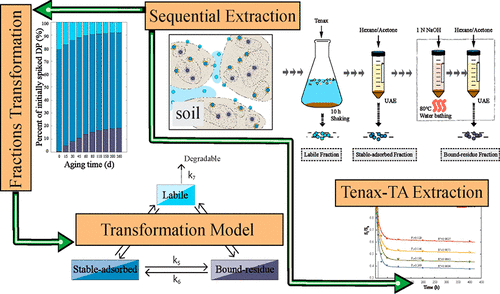当前位置:
X-MOL 学术
›
Environ. Sci. Technol.
›
论文详情
Our official English website, www.x-mol.net, welcomes your
feedback! (Note: you will need to create a separate account there.)
Validation and Application of a 3-Step Sequential Extraction Method to Investigate the Fraction Transformation of Organic Pollutants in Aging Soils: A Case Study of Dechlorane Plus
Environmental Science & Technology ( IF 10.8 ) Pub Date : 2019-01-11 , DOI: 10.1021/acs.est.8b06201 Yu Cheng 1 , Jue Ding 2 , Xianchuan Xie 1 , Xiaowen Ji 1 , Youkuan Zhang 1
Environmental Science & Technology ( IF 10.8 ) Pub Date : 2019-01-11 , DOI: 10.1021/acs.est.8b06201 Yu Cheng 1 , Jue Ding 2 , Xianchuan Xie 1 , Xiaowen Ji 1 , Youkuan Zhang 1
Affiliation

|
A 3-step sequential extraction method was developed to characterize the “labile,” “stable-adsorbed,” and “bound-residue” fractions of Dechlorane Plus (DP) in aging soils. Afterward, the proposed method was used to observe the transformation of DP fractions during aging. Slight decrease of total DP concentrations suggested there was a rather limited degradation, with only 4.2–8.2% of initial DP having degraded after 260 days. The labile fraction, which indicated the bioavailability of DP, decreased from 25.5% to 8.2%. The bound-residue fraction, usually regarded as a route for detoxification, increased from 0.1% to 18.5%. Model simulations were then developed to investigate the transformation, indicating that transformation rates were inconstant and distinguishable over time. Half-lives of DP were estimated to range from 1325 to 2948 days, indicating its environmental persistence in aging soils. Through Sobol Global Sensitivity Analysis (SGSA), degradation was evaluated to be the most sensitive factor of effecting the DP transformation in aging soils. Furthermore, the fsyn values increased from 0.26 to 0.37 in the labile fraction and decreased from 0.25 to 0.18 in the bound-residue fraction. The observed stereoselectivity difference might be the cause of the stereoselective accumulation of DP in terrestrial organisms.
中文翻译:

3步顺序萃取法研究老化土壤中有机污染物的组分转化的验证和应用:以十氯加为例
开发了一种三步顺序萃取方法,以表征老化土壤中脱氯Plus(DP)的“不稳定”,“稳定吸附”和“结合残留”部分。之后,该方法被用来观察老化过程中DP组分的转化。总DP浓度的轻微降低表明降解相当有限,260天后只有4.2-8.2%的初始DP降解。表明DP的生物利用度的不稳定分数从25.5%降低到8.2%。通常被认为是排毒途径的结合残留物分数从0.1%增加到18.5%。然后开发了模型仿真来研究转换,表明随着时间的推移转换速率是不确定的且可区分的。DP的半衰期估计为1325至2948天,表明其在老化土壤中的环境持久性。通过Sobol全球敏感性分析(SGSA),降解被评估为影响老化土壤中DP转化的最敏感因素。此外,f syn值在不稳定级分中从0.26升高到0.37,在结合残基级分中从0.25降低到0.18。观察到的立体选择性差异可能是地面生物中DP立体选择性积累的原因。
更新日期:2019-01-11
中文翻译:

3步顺序萃取法研究老化土壤中有机污染物的组分转化的验证和应用:以十氯加为例
开发了一种三步顺序萃取方法,以表征老化土壤中脱氯Plus(DP)的“不稳定”,“稳定吸附”和“结合残留”部分。之后,该方法被用来观察老化过程中DP组分的转化。总DP浓度的轻微降低表明降解相当有限,260天后只有4.2-8.2%的初始DP降解。表明DP的生物利用度的不稳定分数从25.5%降低到8.2%。通常被认为是排毒途径的结合残留物分数从0.1%增加到18.5%。然后开发了模型仿真来研究转换,表明随着时间的推移转换速率是不确定的且可区分的。DP的半衰期估计为1325至2948天,表明其在老化土壤中的环境持久性。通过Sobol全球敏感性分析(SGSA),降解被评估为影响老化土壤中DP转化的最敏感因素。此外,f syn值在不稳定级分中从0.26升高到0.37,在结合残基级分中从0.25降低到0.18。观察到的立体选择性差异可能是地面生物中DP立体选择性积累的原因。






























 京公网安备 11010802027423号
京公网安备 11010802027423号